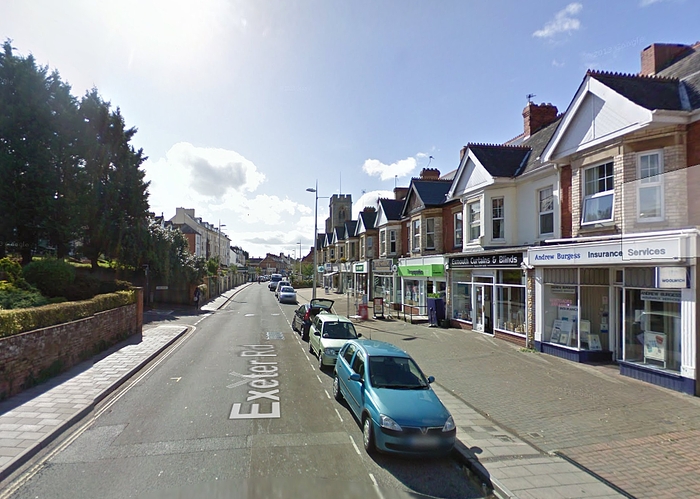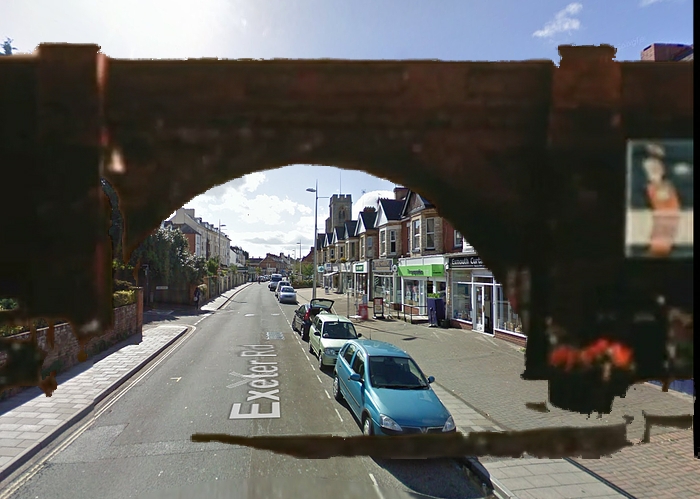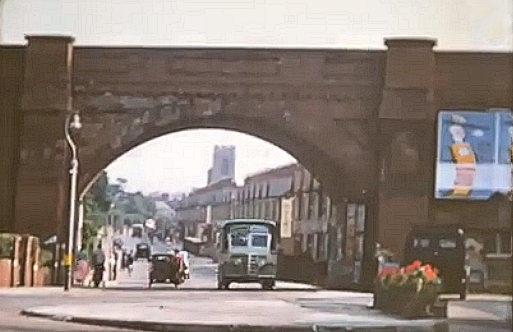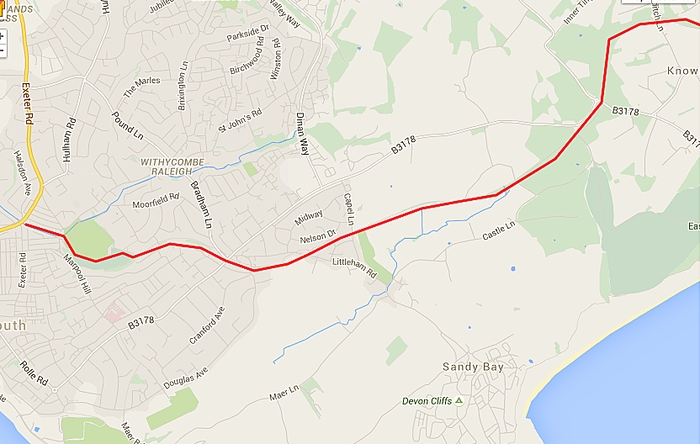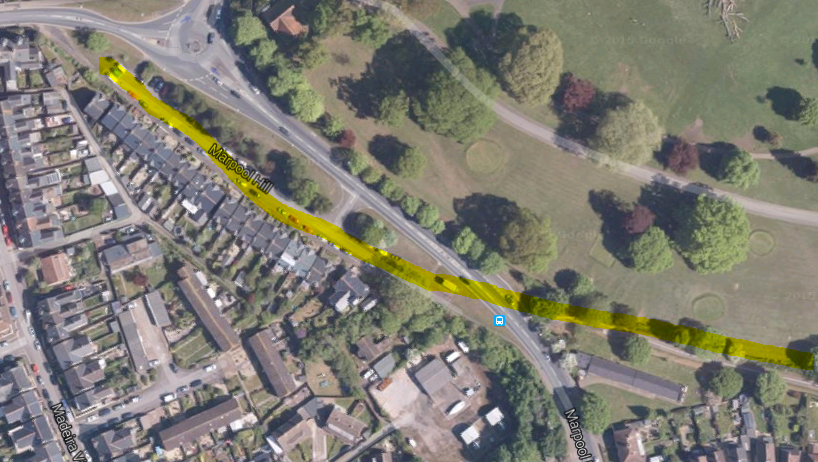|
||
|
||
EXMOUTH 1955 AND OLD RAILWAY BRIDGEupdated 6mar23 - see end
|
||
|
PUBLICITY VIDEO Exmouth Town Council 1955 |
A promotional 16mm film
was commissioned by Exmouth Town Council in 1955 - see link below.
https://www.vimeo.com/39482810 At 15 seconds in, an old bridge is shown and I was intrigued to know where this bridge was as there is no such bridge in Exmouth today. A photo of this bridge is reproduced below: |
|
|
OLD BRIDGE |
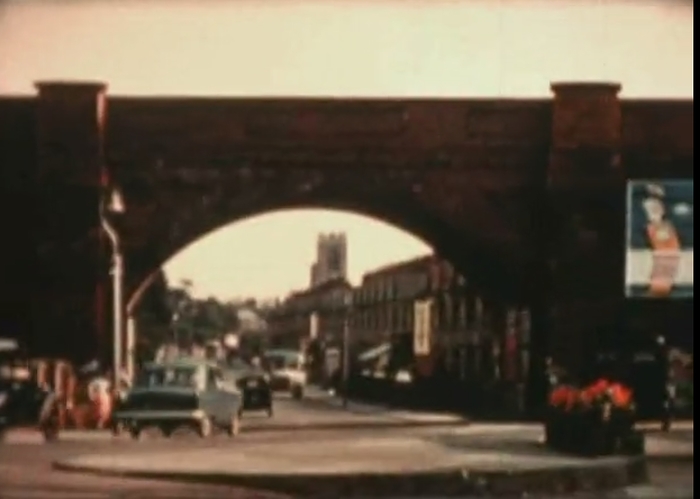
Where was this bridge? The church in the distance provides a clue. It's not Holy Trinity church on Rolle Street as the top of the tower is quite different. There's another large church in Exmouth - All Saints on the old Exeter Road. Here's what it looks like:
Look at the church tower, the three castellations, the tower windows and the bulge on the tower on the left. Clearly this is the church shown in the 1955 film. To make it clear, here's the old bridge superimposed on the Exeter Road picture:
This is where the bridge was. And I've just (13mar23) come across this shot from an old film of Exmouth posted on Facebook by Veronica Worrall:
|
|
|
RECENT INFORMATION |
I
haven't been able to find any reference to this Exmouth bridge, but
there's information about the old Exmouth Railway Station in Wikipedia:
http://en.wikipedia.org/wiki/Exmouth_railway_station Here's an extract:
So the line that went from Exmouth to Budleigh, through Littleham, crossed this bridge over Exeter Road. Neither the bridge, nor the line, now exists and the route of the line is now a cycle track:
The route of the old railway line at the Exmouth end crossed the bottom of Marlpool Hill opposite Phear Park and probably followed the route highlighted below after leaving Exmouth over the old bridge:
Acknowledgement: All maps and street views were taken from Google Maps.
|
|
|
UPDATE: On 30 January 2018 I had an email from Stuart Moon who added the following extra information. I'm pleased that people are still looking at the site and adding their expertise. Thanks Stuart.
Just an observation. The old viaduct in Exmouth is not at the spot
you have outlined. But much closer to the Exeter Road traffic lights
where the new development of flats now stands at around 144 Exeter Road. And further: You have to remember the old railway station was aligned much closer to the houses in New Street and along the line of Marine Way (A376). The current station position is part way along the original station's platform four. The alignment of the viaduct is revealed in the in fill developments in Park Lane, Park Road and Bridge Road where the odd wall lines of the Victorian/Edwardian houses indicate the line of the viaduct. Stand at the foot of Marlpool Hill and there is a small modern terrace of houses with Victorian/Edwardian houses either side. Showing where the viaduct stood. The current Marlpool Hill Road follows part of the original railway alignment before the latter dives into Phear Park and from Chichester Close there is a foot path down to an old overbridge. Enjoyed the research, filled a gap in my lunch hour.
|
||
|
FURTHER UPDATE 6mar23
I've been contacted by 'Exmothian' about the railway. Clearly someone with remarkable inside and personal knowledge. Setting out from Exmouths platforms, You would need to have your engine (Be it) Adams, M7. Ivatt 2Mt, 82 Standard tank or 8000 Riddles ready for quite an early boost of puff for the quite steep viaduct, Or the many arches but first the bridge over 1st The Exeter main road, 2nd The Park road, And Withycombe road arches. But first, Catch your Budleigh Salterton Tablet on your arm from the signalman, Or your going nowhere. The arches themselves were ok! But from the parallel running of Marpole hill to the old scout hut beside Phear park, The lines would get a bit tricky approaching the top of Bradham hill near the main road to Budleigh, (Early morning dew or leaves), I may have to walk beside the engine a little ways with a bucket of sand for a bit of grip? We would collect early morning folk on return from Tipton st John or Sidmouth, Trains were busy back then. Some may have a 100E Ford Pop car? But we took many a passenger to Exmouth and after running around to connect the engine up again, Would then proceed to Exeter. I could run through our workload, But not even know if you get this message? The Docks! I would run the dock goods, Incoming ships of coal, Timber all sorts of stuff? Just me, My trusty 41 Ivatt and *** the regular shunter. Iv remnants of my old Exmouth steam engine I bought at auction I would like to leave to a museum! Old memories donít hurt to keep. Regards clive. PS, The old steam shed was over beside the walkway from the bottom of the colony through to the south western pub.(Something walk?) Beside the taxi rank, Opposite the fish n chip shop. (In view of the Strand gdns.) Next up was the coal depot, Bus depot and the pathway to the Railway club? And the King George the V ground?.. The steam shed would house 3 or 4 engines, We would clean our own fires and tend to! Just one pit?? And water column? And a very good small bunch of fireman/ Drivers. AND MORE As the steam engines were slowly withdrawn, I would ever more often have to take out the likes of the 1000 Western or the 800 Warship or Hymek diesel types of locomotive. Times changed? Big and impressive mainline engines, But not as good as the old steam engines. In the cut back of hundreds of footplate men, I would eventually be made redundant!. So I would go work overseas. Met President Carter of the USA, And later, A footballer named Pele! (late 70s in Africa) Still kick myself for not getting Peles autograph. But a big crowd prevented that. (Bedlam) And the pathway by the old Exmouth steam shed? Was it Lambeth, Perry? Or something? (Came out by the old South western pub from the lower end of the collony). And yes, I was answering your bit about the brick arches that ran up to the Phear Park. Dont spose anyone remembers that now! And did they ever find the lions on the Phear park entrance pillars?? US army soldiers would billet there in 2nd world war! Best regards. (No need to mention all this bit Ian) Just the lower bit if you want? Maybe someone remembers the old Steam Engines. Some of my old ones are preserved at Swanage, Bluebell, etc. Dont think any Exmouth Branch engines were spared the cutting torch unfortunately / As far as I know?. And best regards to any Harry Harrison (Headmaster) boys out there from the Secondary Modern up by Moorfield rd... Please just refer to me as an Ex Exmothian? I want no fuss! Maybe Ex Secondary Modern lad? Those old Exmouth engines would supply many VW vans to Sidmouth conversions! Into splendid VW Campers! All the rage in the very early 60s. I would pull trains of them of many colours! Rainbow trains!? Early 60s Reg? Wonder if any still about? EVEN MORE There seems some confusion on the run of the arches, You would get to the signal box going hard, Dont miss the single running tablet!. It could sometimes bruise your arm, (Like Topsham on a non stopper) The first arch was just short of smales car place on the jct of the road that goes out to mudbank! (End of the Victorian houses on other side of the Exeter road!) Youve climbed up quite high? Some confusion over the first double decker buses down from Exeter. Think they ran down Gypsy lane. Brick arches crossed half way up Park road, But top end of Withycombe road. This crossing was a level Braithwait type of conventional railway bridge! This was further away from the houses on Marple rd / hill where you show on your map.. A line roughly where the new road is now shown! About 30/40 yards inwards of the old scout hut. Then the perimeter of phear park. Adams O2, or M7 0-4-4, A large reverser for shortening the inlet stroke, Ivatt or 82 Standard to 8000 Riddles would be a winder, It was a pull to go over a double decker bus in so short a run, You could cut back a bit if pos! This shortens the walshaert stroke to conserve coal burning! But at times like this (You can witness on Sidmouth bank out of Tipton, Or St Davids bank up to Exeter central, In short, Dont spare the horses, Give it welly!! The brick arches were well presented, Those lucky to own a workshop or garage under them were doing ok. I think offhand there were twenty seven of them, A lot, Just huge arches. The Withycombe road steel one was full of pidgeons. Homing pidgeons who had lost their way!. Rings on their legs n all. They nested there, Not many folk know that. Blue barrs, Chequers etc. You never see pidgeon racing now?? Do you? The Arches, Exmouths Victorian backbone!
|
||

